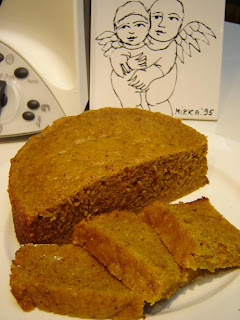
Well, another cauliflower soup - just for a change. One that uses the Thermomix to firstly grind the almonds to speed up cooking and then cooks the soup and finally blitzs it to a smooth velvety finish.
Cauliflower and Almond Soup
Ingredients:
few saffron threads
1/2 MC (50ml) water
100g almonds
1 large onion, peeled and quartered
1 Tbsp vegetable oil
500g cauliflower, cut into chunks
1000g stock, chicken or vegetable
freshly ground nutmeg
salt and pepper
100ml cream
Method:
Place saffron threads into the water and keep aside.
Place almonds into TM bowl and grind for 30 seconds on Speed 9. Remove and set aside.
Place onion into TM bowl and chop for 10 seconds on speed 5. Add oil and sauté for 4 minutes at 90°C on Speed 1.
Add cauliflower to TM bowl and chop for 10 seconds on speed 5.
Add stock, nutmeg, salt and pepper to TM bowl and cook for 15 minutes at 90°C on Speed 1. Add almonds and saffron in water to TM bowl and cook for 10 minutes at 90°C on Speed 2.
Make sure the MC is in place and slowly increase the Speed up to 9 for 30 seconds. Add the cream and blend for 20 seconds on Speed 4.
Transfer to a serving dish and decorate with more cream over the top.





















































